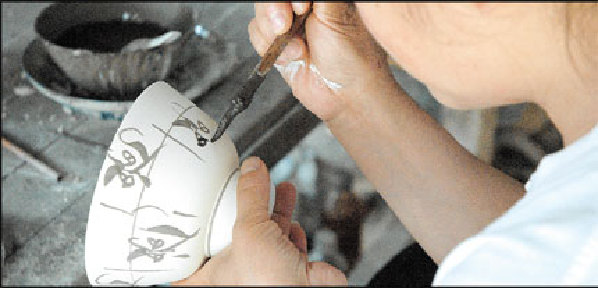Lofty Lushan Mountain
Temples in Hidden Places
On the First of August
Wheels by the Water
Share your travel story with regional@chinadaily.com.cn
One day in Jingdezhen: China's porcelain hub
By Laura Imkamp ( English.news.cn, ShanghaiDaily.com )
Updated: 2011-07-04

One of the masters at the Ancient Kiln Exhibition Center in Jingdezhen paints the design onto a bowl before it's glazed. When the bowl is fired, the black ink will turn blue. (Source: ShanghaiDaily.com/Laura Imkamp)
It's 9am on a sunny spring morning in Jingdezhen and I'm getting off a plane from Shanghai with eight other women. They're all there for one thing: porcelain.
Jingdezhen in Jiangxi province has been China's porcelain capital for about 1,800 years and as we ride into town from the airport, the signs are everywhere: giant vases, billboards advertising porcelain shops; even the lampposts are decorated in porcelain.
It's a unique heritage and an important one in Chinese history. The porcelain from Jingdezhen is said to be "as thin as paper, as white as jade, as bright as a mirror, sounding as clear as a chime."
The words "porcelain" and "china" are basically synonymous, thanks in large part to this town, where the emperor Jingde (968-1022) laid the groundwork for top-quality ceramics during the Song Dynasty (960-1279).
In fact, Jingdezhen native Natalie Wu, 29, says this may even be where the country's English name "China" comes from. The city was once named Changnanzhen, which, according to local legend, was difficult for foreign traders to pronounce. They shortened "Changnan" to "China," and, somehow, that stuck.
Eventually the emperor renamed the town Jingdezhen, after himself, to solidify his role in developing the porcelain trade. The city is still one of the world's porcelain hubs today, but as we make our way to one of the porcelain markets, there's not much in the way of scenery.
Indeed, most of the tourism here is somehow connected with the main industry rather than sightseeing.
Case in point: the women I'm with are here for today only, to buy porcelain at a fraction of what it would cost in Shanghai.
It's still fairly early when we get to the International Trade Square market, and since I'm not here just to shop, Wu - a part-time tour guide and part-time antique pottery student - and I head over to the Ancient Kiln Folk Exhibition Center. It's almost like an assembly line here. Everything is hand-made by retired ceramics masters, each specializing in a particular step.
The first master shapes the bowls; the second trims and reshapes them; the third applies a layer of glaze; the fourth paints, and so on through every step of the process from the initial shaping to the final firing.




